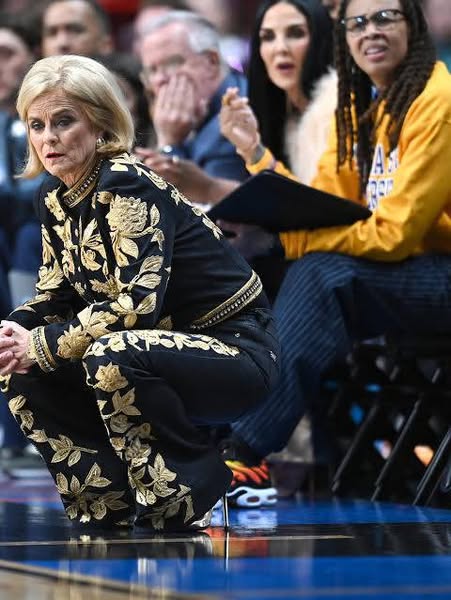The Broken State of College Sports—And Kim Mulkey’s Exhaustion Proves It
College sports, once celebrated as a pinnacle of amateur athleticism and school spirit, are now mired in controversy, hypocrisy, and institutional failure. The exhaustion expressed by legendary LSU women’s basketball coach Kim Mulkey is a glaring symptom of a larger, systemic problem that plagues collegiate athletics. While Mulkey’s situation is unique in some ways, it underscores the broader challenges facing coaches, athletes, and universities. The current state of college sports is a convoluted mess of financial exploitation, ethical dilemmas, and unsustainable expectations—problems that demand urgent attention and reform.
The Unchecked Commercialization of College Athletics
One of the most glaring issues in college sports is the unchecked commercialization that prioritizes profit over the well-being of athletes and coaches alike. The NCAA and major conferences generate billions of dollars in revenue from broadcasting rights, sponsorships, and ticket sales. Yet, for decades, athletes were denied the right to earn compensation for their contributions. Even now, with the emergence of Name, Image, and Likeness (NIL) deals, the playing field remains uneven. Big-name programs and athletes benefit significantly while others struggle to navigate this new financial landscape.
For coaches like Kim Mulkey, the commercial pressures are immense. The demand to win championships, attract recruits, and generate revenue for the university can be overwhelming. The scrutiny from fans, media, and boosters only amplifies the stress. Mulkey’s exhaustion is not just about coaching basketball—it’s about managing a multi-million-dollar enterprise under relentless pressure.
The Exploitation of Student-Athletes
College sports rely on a system that has historically exploited student-athletes, particularly in revenue-generating sports like football and basketball. The NCAA’s model, which long denied athletes the right to earn compensation, is crumbling under legal and public scrutiny. The introduction of NIL rights is a step forward, but it has also created a chaotic environment with little regulation. Wealthier programs and athletes secure massive deals, while others are left behind, widening the gap between powerhouse programs and smaller schools.
Mulkey, a fierce advocate for her players, understands the challenges they face. The pressures of balancing academics, training, and financial concerns weigh heavily on athletes. Unlike professionals who have access to full-time financial and legal advisors, many college athletes are navigating NIL deals on their own, leaving them vulnerable to exploitation by agents and third parties.
The NCAA’s Failures and Inconsistencies
The NCAA’s governance is another major factor contributing to the dysfunction of college sports. From inconsistent rulings on athlete eligibility to its inability to regulate NIL deals effectively, the organization’s failures are well-documented. It continues to act reactively rather than proactively, leading to confusion and frustration among coaches and athletes alike.
Kim Mulkey’s frustrations with the NCAA are not unique. Many coaches have criticized the organization for its lack of clear guidelines, particularly regarding the transfer portal and NIL. The transfer portal has revolutionized college sports, but it has also created instability, as players frequently switch schools in search of better opportunities. While mobility can be beneficial, it has also made roster management a nightmare for coaches, who must constantly recruit not only high school players but also their own athletes to prevent them from leaving.
The Mental and Physical Toll on Coaches and Athletes
The mental health crisis in college sports is another issue that cannot be ignored. Coaches like Kim Mulkey operate in high-stress environments where job security is tied directly to performance. The pressure to deliver results, manage egos, and maintain control over an ever-evolving landscape takes a toll. Reports of burnout, anxiety, and depression among coaches are increasingly common.
Athletes, too, face immense mental and physical challenges. The rigorous demands of training, travel, academics, and performance expectations can lead to burnout and exhaustion. While initiatives to address mental health in college sports have gained traction, there is still a stigma surrounding these issues, making it difficult for athletes to seek help without fear of being perceived as weak or uncommitted.
The Gender Disparities in College Sports
While much of the conversation around the broken state of college sports focuses on financial and regulatory issues, gender disparities remain a persistent problem. The inequities between men’s and women’s sports programs are well-documented. From disparities in facilities to media coverage and NIL opportunities, female athletes often receive fewer resources and less recognition than their male counterparts.
Mulkey, as a leader in women’s basketball, has had to navigate these inequities throughout her career. While she has been successful in advocating for her programs, not all women’s sports coaches have the same platform or influence. The fight for equity in college sports is ongoing, and until systemic changes are made, female athletes and coaches will continue to face significant disadvantages.
The Path Forward: Reforms and Solutions
Fixing the broken state of college sports requires a multi-faceted approach. Some key reforms that could address these issues include:
- Comprehensive NIL Regulation – The NCAA or a federal governing body must establish clearer guidelines to ensure fairness and transparency in NIL deals. This would help prevent exploitation and create a more level playing field.
- Better Support Systems for Athletes – Universities must invest in financial literacy programs, mental health resources, and career counseling to better support student-athletes both during and after their college careers.
- Coaching Support and Work-Life Balance – Schools need to recognize the mental and physical toll coaching takes and implement measures to reduce burnout, such as mandatory rest periods and increased support staff.
- Gender Equity Reforms – The NCAA and individual universities must take proactive steps to ensure equal investment in men’s and women’s sports programs, from facilities to promotional efforts and NIL opportunities.
- Reevaluating the Transfer Portal – While player mobility is important, implementing guidelines to maintain competitive balance and roster stability could help prevent the chaos that currently exists.
Kim Mulkey’s exhaustion is a reflection of the broader dysfunction in college sports. The immense commercialization, athlete exploitation, regulatory failures, mental health challenges, and gender inequities all contribute to a system that is increasingly unsustainable. While changes such as NIL rights and the transfer portal have reshaped the landscape, they have also introduced new challenges that need to be addressed. Until systemic reforms are implemented, the exhaustion and frustration felt by coaches like Mulkey—and the countless athletes navigating this broken system—will only continue to grow. College sports need a reset, and the time for meaningful change is now.



